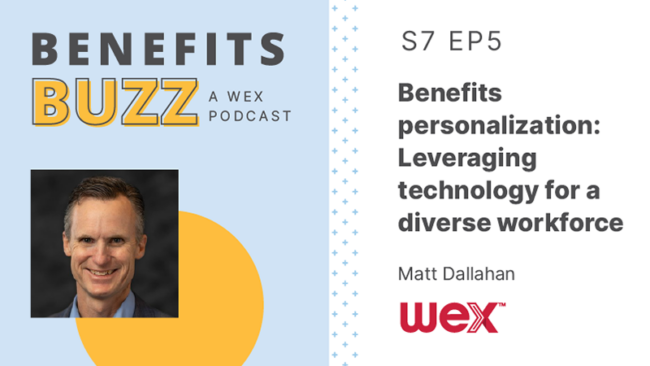Stay connected
Subscribe to our Inside WEX blog and follow us on social media for the insider view on everything WEX, from payments innovation to what it means to be a WEXer.

In today’s world, employees seek more than just a paycheck. They desire benefits that cater to their unique needs and offer peace of mind. This is where benefits personalization technology comes into play. Let’s explore how modern technology is revolutionizing benefits personalization and how employers can leverage these advancements effectively. And don’t forget to check out our Benefits Buzz podcast episode with Matt Dallahan, vice president of product management at WEX, below.
Personalized benefits are about more than offering a generic set of options. Employees who feel that their benefits package is tailored to their specific needs are likely to experience increased job satisfaction and loyalty. Matt Dallahan commented, “78-80% of employees said they’d be more likely to stay in their job with their current employer if they had better benefits or they felt like they’re getting more value out of their benefits.” So it is crucial to understand what your employees need from their benefits and personalize offerings that cater to them. Even further, offering personalized benefits could actually help attract and retain top talent. All in all, personalized benefits are a game changer when it comes to increasing employee job satisfaction and loyalty, as well as a vital tool to attract and retain talent.
The integration of technology into benefits personalization involves using data to create experiences tailored to individual employees. This can look like utilizing claims data and platforms like CRM’s to deliver digital experiences and personalized messages. Another way to personalize benefits further can be through your benefits portal. When employees log into their benefits portal, they can receive tailored messages and reminders about their benefits options, ensuring they are informed and engaged. For example, an employee who has recently had a child might receive information about adding dependents to their health insurance or exploring childcare benefits. This kind of targeted communication ensures that employees receive relevant information when they need it, providing further personalization.
Implementing a personalized benefits strategy comes with its challenges, particularly concerning data privacy and comfort with new technology. One way to overcome these challenges is by starting with simpler technologies that employees are already familiar with, such as chatbots. These tools can handle basic questions and provide immediate assistance, easing employees into the idea of technology-driven personalization. Additionally, ensuring robust data protection measures can help alleviate privacy concerns. When using sensitive information, such as health claims data, it is crucial to comply with regulations like HIPAA. Providing clear communication about how data will be used and ensuring that participation is optional can help build trust among employees.
The effectiveness of personalized benefits can be measured through several key performance indicators (KPIs). One important KPI is the appropriateness of insurance coverage among employees. Ensuring that employees are neither over-insured nor under-insured can lead to cost savings and better protection. A good question to ask is, “How is your population doing relative to the decisions they’re making and are they appropriately insured with the right level of protection?” Another important KPI is engagement with benefits resources. Tracking how often employees access and utilize resources provided can indicate the success of a personalization strategy.
Looking to the future, the role of technology in benefits personalization will continue to evolve. Employers can expect to see more advanced tools that provide detailed guidance during key life events. For instance, when an employee is diagnosed with a medical condition, they could receive personalized recommendations about their health plan options, wellness programs, and other relevant benefits. All in all, whatever new technology breaks into the industry, the key goal will remain the same: providing robust benefits packages and experiences that cater directly to your employees to increase their happiness and well-being.
Learn more about employee benefits by subscribing to our blog!
The information in this blog post is for educational purposes only. It is not legal or tax advice. For legal or tax advice, you should consult your own legal counsel, tax and investment advisers.
WEX receives compensation from some of the merchants identified in its blog posts. By linking to these products, WEX is not endorsing these products.
Subscribe to our Inside WEX blog and follow us on social media for the insider view on everything WEX, from payments innovation to what it means to be a WEXer.